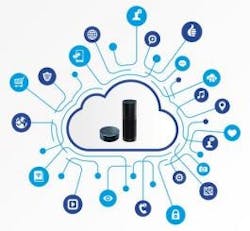It’s a powerful, fun tool. Just plug it in, connect it to your WiFi, and Alexa can manage your entire house: locking and unlocking doors, controlling the lights and window shades, catering to your family member’s unique climate comfort needs, playing your favorite music, giving you an update on relevant news, reducing the household energy bill and even making it too easy to buy products from Amazon…all voice-activated without any complicated programming.
If you haven’t tried it yet, you should. It is extremely cool–it can be a bit habit-forming.
But these kinds of voice-control technologies are not just for home use. If you are part of the facility-management or building automation/controls community (like I am) Alexa might make you and other members of our community feel old, unimaginative, and so last century. In some ways, when it comes to new and potentially “disruptive” technologies, we are the parents that wear sweaters and dad jeans, and justify our dated fashion sense by claiming that we are just being responsible.
Consider the Building Management System (BMS) used to control systems within a facility, office or industrial plant. Out of all the commercial real estate in the United States, a fraction is managed by a BMS because the rest of the market is too small or unsophisticated to be able to handle a BMS. So the debate rages regarding how to leverage the “power of the BMS” to the other, say, 80%. And even more curious, many of the 20% of the facilities that actually have a BMS are not utilizing the technology to its fullest.
Why? What is the challenge?
In the midst of all this negativity and fear, let us consider my (not especially talented) 12-year-old nephew who, in less than an hour, set up his mother’s Alexa and essentially created his “home BMS.” In just a few minutes, he made his home instantly more managed, controlled, safe, and energy-efficient than at least 80% of commercial real estate. Why don’t building managers follow his footsteps? Maybe we need to stop being so entrenched in our beliefs about what a BMS is or should be. It’s time to leverage the successes of the consumer sector that is, in many ways, out-innovating us.
For me, a few key aspects jump out. Number one, all these “smart things” in the home–locks, thermostats, motion-sensors, washing machines, lights—have their own cloud point-of-presence and their own applications. Each of these things has a visible dashboard on the consumer’s smart phone through their own cloud and is individually controllable through the app.
Number two—Alexa is able to communicate with and control these smart things, and as a result scenarios such as “if the door is opened by a particular smart phone user, turn on the lights and heat up a specific room in the house” become simple to implement, with little or no programming required.
How does this all work?
The Alexa cloud receives voice commands uploaded from the home microphone/speaker system, converts that information into a digital instruction for the desired scenario, and then establishes links to that user’s various cloud accounts (the music cloud, the lock cloud, the light cloud, the thermostat cloud, and so on), and invokes the right Application Programming Interface (APIs) calls to make the desired actions happen. Note that all this “system integration” is happening in the cloud. It’s the device clouds that talk to each other; it’s not the devices in the house talking to each other.
So how do these lessons apply to the facility management and building automation market?
Doing so, in effect motivating every vendor to provide an app, is good not only for the facility manager, but for all the vendors as well, because it greatly improves the vendor’s ability to continue to add value to the facility manager with better service and operational insights.
For legacy devices that are already installed and are pre-cloud, the facility manager can utilize a common facility-device cloud solution that automatically discovers all the automation and control devices in the facility. For example, all the BACnet-based devices in the building—then create a virtual cloud instance for each device, essentially virtualizing the facility’s network. Once all the devices and sub-systems (and their access and data) are represented in the cloud, the facility manager should develop their own Alexa-inspired BMS with an integrated point-of-control that is intuitive and fun to use. Will this transformation be as easy as installing Alexa in a home? Maybe not, but that should be the goal.
Sure, some facility managers will grumble about the lack of standard data models. However, this is a moot point as the Alexa use case does not require standard data models–the RESTful APIs published by each device vendor are good enough. The naysayers will talk about security. I would argue that securing a home with young children may be just as important as securing a facility–so let’s accept that security is a serious issue that must always be front and center, but it’s an issue that applies across sectors.
We need to think outside of the box. We need to explore new ways to drag our industry into the future. Our community needs to reinvent the BMS by integrating new, disruptive technologies that add more control and capabilities to facility managers.
Varun Nagaraj is the President and CEO of Sierra Monitor Corporation.






